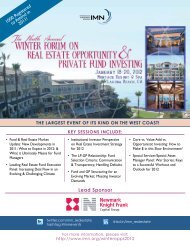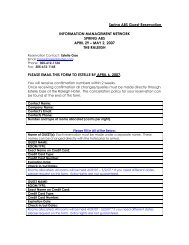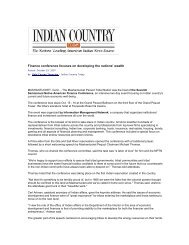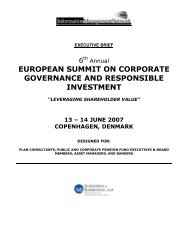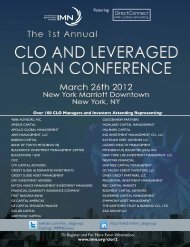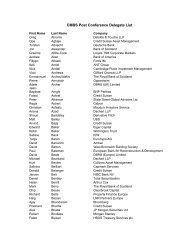Asset-Backed Alert - IMN
Asset-Backed Alert - IMN
Asset-Backed Alert - IMN
You also want an ePaper? Increase the reach of your titles
YUMPU automatically turns print PDFs into web optimized ePapers that Google loves.
April 12, 2013<br />
<strong>Asset</strong>-<strong>Backed</strong><br />
5<br />
ALERT<br />
S&P Gets Look at ‘Mock’ Solar Deal<br />
A government-sanctioned organization is constructing a<br />
prototype securitization of leases on solar-power equipment,<br />
with the aim of determining whether such issues could earn<br />
high-enough ratings to be feasible.<br />
The undertaking is the product of Solar Access to Public<br />
Capital, a group of about 40 companies brought together by the<br />
U.S. Department of Energy’s National Renewable Energy Laboratory<br />
with the aim of creating a market for solar-equipment<br />
securities. SolarCity is playing the role of issuer on the model<br />
deal, with Credit Suisse as the underwriter — mirroring a relationship<br />
that the shops already have in place for an actual offering<br />
that’s in the works.<br />
The theoretical transaction would total $50 million and would<br />
be based on a portfolio of leases on residential installations. The<br />
plan is to submit the sample to S&P prior to the July 8 start of the<br />
“Intersolar North America” conference in San Francisco.<br />
A second model securitization involving installations on<br />
commercial buildings will also be presented to S&P, with Credit<br />
Suisse again acting as underwriter. However, no issuer has been<br />
assigned for that side of the project.<br />
The goal in both cases is to determine whether S&P will<br />
grade the securities double-A or higher, which is the level that<br />
prospective issuers see as necessary to move forward with their<br />
inaugural offerings.<br />
Why assemble a model securitization? Ever since companies<br />
like SolarCity began expressing an eagerness to securitize<br />
more than two years ago, rating agencies have hesitated over<br />
the complexities and unfamiliar nature of the targeted assets.<br />
The view is that an informal mark from S&P, which has yet to<br />
officially sign on to grade the sample deal, could help issuers<br />
tweak their offerings to ensure broad appeal from the start —<br />
rather than floating potentially lower-rated transactions that<br />
could dampen enthusiasm for the asset class.<br />
S&P’s concerns about solar-equipment deals have included<br />
a lack of historical lease-payment data. The Department of<br />
Energy and the Solar Access group are answering by drafting<br />
standard power-purchase and lease contracts and by creating a<br />
database of lease performance.<br />
That said, it’s unclear why the focus is on how S&P alone<br />
would rate the deals. Credit Suisse, which already has supplied<br />
financing to SolarCity and prospective issuer SunRun, was in<br />
talks with Moody’s last year about possibly grading deals of<br />
$500 million from each company. And while Moody’s is not a<br />
member of the Solar Access group, it has been talking to the<br />
Department of Energy about its approach to the market.<br />
S&P is a member. So are Kroll, Credit Suisse, SolarCity, Sun-<br />
Run and most other solar-equipment solar installation and<br />
leasing companies interested in securitization. <br />
Budget Cuts Leave Brazos in Limbo<br />
The U.S. Department of Education is withholding a servicing<br />
contract that it was poised to award to Brazos Higher Education,<br />
pushing the education lender’s securitization plans onto<br />
the backburner.<br />
The Department of Education had been looking at mid-<br />
June to add Brazos to a list of not-for-profit servicers assigned<br />
to handle collections on government-originated Direct Loans.<br />
But on April 1, the agency said it would halt such assignments<br />
at least until the end of its current fiscal year on Sept. 30.<br />
That decision, brought on by the federal spending cuts<br />
known as sequestration, came as a shock to Brazos. In fact, the<br />
Waco, Texas, lender already had spent $2 million and hired 20<br />
people in anticipation that it would receive the contract.<br />
So what does that have to do with Brazos’ presence in the<br />
asset-backed bond market? The company, once an active<br />
issuer, had been eyeing the assignment as a key source of fee<br />
income at a time when many of its other lines of business dried<br />
up — with the idea that it could use the revenues to launch or<br />
expand other lending projects that it eventually would fund via<br />
a renewed securitization program.<br />
In the three years since the Obama Administration blocked<br />
private-sector lenders from writing fresh loans via the Department<br />
of Education’s Federal Family Education Loan Program,<br />
those shops have been pursuing Direct Loan servicing contracts<br />
as a revenue lifeline. In the meantime, many have seen<br />
their lending volume founder.<br />
Brazos wrote only $300,000 of non-government private<br />
loans in 2012, giving it little in the way of fresh assets to securitize.<br />
The company was negotiating for a $10 million warehouse<br />
line from a regional bank, with the goal of using the capital<br />
to write and eventually securitize loans to students of trade<br />
schools and specialized training programs. But that deal never<br />
materialized.<br />
Brazos has sought alternative sources of revenue in the meantime,<br />
including its December purchase of online job-interview<br />
service InterviewStream. But any securitization plans — seen as<br />
a driver of ongoing lending growth — now are on hold until the<br />
company learns of its future as a Direct Loan servicer.<br />
The Department of Education’s intentions on that front<br />
are unclear. In the meantime, Brazos will lay off the workers<br />
it hired. It also will submit a letter to the agency next week<br />
explaining the importance of the contract and urging for a<br />
quick resolution.<br />
Brazos began issuing student-loan backed bonds in 1995,<br />
and to date has completed 42 deals totaling $15.7 billion,<br />
according to <strong>Asset</strong>-<strong>Backed</strong> <strong>Alert</strong>’s ABS Database. It last was in<br />
the market in August 2012 with a $115.2 million issue, with<br />
Morgan Stanley as bookrunner. <br />
Corrections<br />
An April 5 article, “CLO Issuers Mulling Capital Calls,” overstated<br />
the spread for a class of a Carlyle Group collateralized<br />
loan obligation. The 5.4-year senior tranche of the deal, Carlyle<br />
Global Market Strategies, 2013-2, priced at 115 bp over threemonth<br />
Libor.<br />
An item in The Grapevine on April 5 misidentified the headquarters<br />
of Ares Management. The firm is based in Los Angeles.



